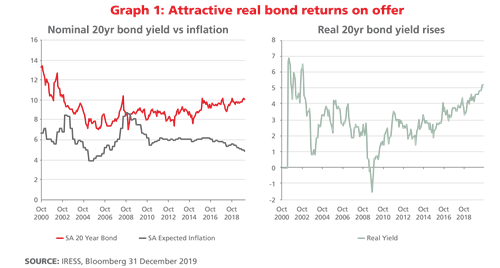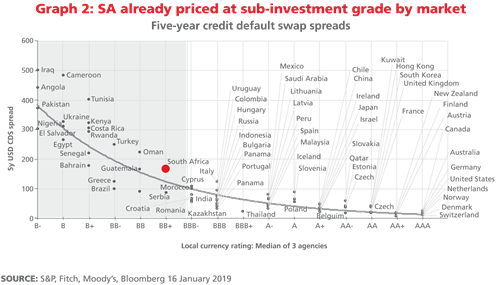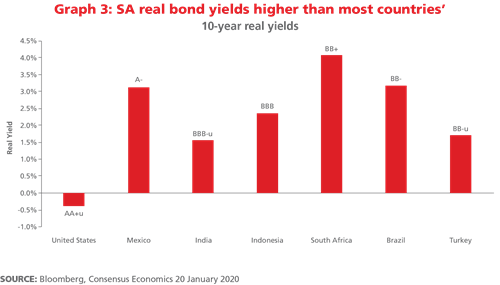Can you bet on South African government bonds now?
Article Summary
This article is from the Quarter 1 2020 edition of Consider this. Click here to download the complete edition.
Our bonds are pricing in an excessively high risk premium at the start of 2020, argues Portfolio Manager Roshen Harry, and investors should take advantage of the high yields on offer.
Key take-aways
- The SA bond market is facing the threat of a downgrade to sub-investment grade level by Moody’s, which would expel our bonds from the World Government Bond Index and prompt sales by index-trackers and investors unable to hold sub-investment grade bonds.
- While there are different views of the bond market reaction should this happen, at Prudential we believe this is already largely priced into current bond yields, and that therefore the risk to investors is less than many believe. Our most likely scenario is for some initial strong selling followed quickly by buying by investors wanting the attractive yields on offer. We believe the yields now on offer are attractive, adequately compensating investors for this risk already.
Going into 2020, South Africa faces weak growth, persistent fiscal concerns and a possible ratings downgrade. In addition, December’s bouts of power cuts have weighed on market and consumer confidence and raised the chances of the economy moving into a recession. The Medium-Term Budget Policy Statement (MTBPS) delivered in October 2019 forecasts the public debt-to-GDP ratio to reach a worryingly high 71.3% in 2022/23, with no debt consolidation in sight – news which was not well received by the market. Some assert that the MTBPS was used as a tool to signal to government the country’s urgent need to embark on its reform agenda, which would boost much-needed growth. This, in turn, would increase revenue collections over time and pave the way for an improvement in public finances, ultimately reducing the cost of capital. Whatever your view, it is clear the fiscal position has added to the basket of risks which have weighed on the local bond market, given that any further fiscal blow-outs would result in the government having to issue more debt.
Entering the new year against this backdrop, one factor that will be hanging over our government bond market is the increased risk of a downgrade by Moody’s Investor Services (Moody’s) of our sovereign investment grade rating from Baa3 to a sub-investment grade rating. This downgrade would result in the automatic expulsion of South African government bonds from the World Government Bond Index (WGBI). What would be the effects of this move?
Possible impacts of exclusion from WGBI
One view is that this exclusion will cause foreign investors to sell between US$3 billion and $10 billion of our government bonds. With these bonds needing to find a home, bond yields would, as a result, increase meaningfully.
Another view suggests that the WGBI investor exposure to South African bonds is only moderate, and so an increase in yields from a WGBI exclusion would be only temporary, as non-benchmarked investors and local fund managers would snap up the bonds as they became attractive. A third view is that the downgrade to sub-investment grade could ease market uncertainty, which could result in the stabilisation of government bond yields.
As is the norm in any well-functioning market, there are clearly a range of differing views on this topic. By and large, however, investors appear to be generally pessimistic with respect to South Africa’s growth prospects and fiscal health in the medium term. That pessimism, we think, is largely reflected in the elevated level of government bond yields in the local market. This article will try to provide some reasons as to why we at Prudential think South African (SA) government bonds offer value for investors at their current yields.
Prudential’s view on SA government bonds
Considering all of the negative factors above, our view is that much of the prevailing pessimistic sentiment is already priced into government bonds, and therefore any potential bond market sell-off will not be as severe as many anticipate – after all, markets are forward looking. Consequently, we consider these assets to be cheaply valued, offering attractive returns in the medium term (over three to five years). Below I discuss inflation as an important factor, as well as three key measures which support our view (historic real bond yields, relative credit default swap spreads and relative real bond yields), keeping in mind that this is not an exhaustive list. These measures do, however, form part of our investment decision-making process.
Inflation
When looking at bond yields it is important to consider inflation, given that it erodes the purchasing power of the returns investors receive over time. The higher a country’s inflation rate is expected to be (inflation expectation), the higher the yield an investor should require to compensate for this erosion of purchasing power. The yield investors receive after adjusting for inflation is called the “real” yield. Currently, SA inflation outcomes show subdued inflationary pressures, much like most of the developed world, at 4% y/y in December 2019, well below the South African Reserve Bank’s mid-point inflation target of 4.5%. Meanwhile, according to the Bureau for Economic Research (BER)’s fourth quarter 2019 survey, expectations for headline inflation are trending downwards towards the SARB’s mid-point target, now at 4.5% for 2019 (from 4.6% in the previous quarter). Inflation expectations for 2020 and 2021 have continued to ease gradually and are at 4.8% and 5.0%, respectively, the lowest levels since 2007, and five-year-ahead inflation expectations have also declined to 4.9% from 5.0%. Two years ago the latter was closer to 6%, at the upper end of the SARB’s 3-6% inflation band.
High real bond yields
Looking at absolute yield levels as of 16 January 2020, long-dated government bonds as measured by the 10- and 20-year bonds are yielding about 9.0% and 10.10% respectively, at the upper end of their trading range over the past four years. SA’s subdued inflation gives investors who buy long-dated bonds the ability to earn attractive real yields of about 4.5% to 5.6% in the 10- to 20-year tenors, assuming inflation is anchored at 4.5% over the term of the bonds. Using the Bloomberg consensus headline inflation forecasts for 2020 and 2021 of 4.7 and 4.8% respectively, inflation is expected to be well behaved in the near term. Alternatively, using BER’s five-year inflation survey, the longer- term inflation outlook has also moderated. Remember that investors are still assuming inflation risk, in believing that the SARB will continue to exercise its mandate successfully and not lose its credibility by letting inflation run back to the upper end of its inflation target band and beyond. Should inflation return to the 6% level, the real return on long-dated bonds would fall to 3% to 4%, but we would still consider to be an attractive return proposition.
Graph 1 (in the left box) plots the yield-to-maturity of our 20-year government bonds since the year 2000 alongside SA’s expected annual inflation rate. The right box illustrates real yield, which is the difference between the bond yield and SA inflation. They clearly highlight that real yields are at elevated levels compared to the observation period. They are also well above our view of their long-run fair value (which is around 2.5%). Hence this supports our conviction that long-dated government bonds offer attractive returns over the medium term.

Elevated relative credit default swap spreads
Another way to measure how the market is valuing South African debt is to compare the country’s credit default swap (CDS) spread versus other countries. A CDS can be thought of as an insurance policy that can be bought against a default or other credit event by the debtor. They are essentially derivative contracts that transfer credit exposure between counterparties. The higher a country’s credit rating, the lower the CDS spread (since there is less risk involved in holding their debt) and vice versa.

Graph 2 shows the five-year CDS spreads of investment and sub-investment grade countries, with the latter plotted in the shaded area. South Africa’s CDS spreads are already trading at about 170 basis points (1.7%, as shown by the red dot), comparable to countries that have sub-investment grade ratings of BB. Equally, countries rated in the lower range of investment grade (BBB-) are trading at CDS spreads of 75 to 125 basis points (0.75% to 1.25%), lower than South Africa. This clearly shows the market is already pricing South African debt at sub-investment grade.
Based on this observation, we could infer that should Moody’s downgrade SA to sub-investment grade, the odds of further extended weakness in our government bond market are rather slim. There could be initial knee-jerk selling following the news of a downgrade, but we believe this could evaporate rather quickly as investors see a good buying opportunity.
Of course this scenario bars any further deterioration in the national fiscus that might occur this year, should projected debt levels continue to rise more sharply than expected or the economic growth outlook worsen even more. This could then cause a shift in market expectations toward further downgrades to come, and more bond market weakness as the government would be forced to borrow more. Hence the urgent requirement for fiscal responsibility and growth-enhancing reforms.
High relative real bond yields
Finally, Graph 3 compares 10-year real bond yields across some of South Africa’s peer countries, where our government bonds undeniably stand out as offering very attractive real yields. Using the S&P long-term local currency rating, SA has a higher credit rating than both Brazil and Turkey, and can offer highly developed, deep and liquid financial markets along with strong macroeconomic institutions that are viewed as credible by international institutions; yet it offers higher real yields to investors. Equally, the graph shows the unattractive (negative) real yield on 10-year US Treasuries, indicating their poor return prospects. Real returns are even more negative on most European government bonds. Although SA’s long-dated bonds could weaken further, if an investor is willing to ride out the volatility over the medium term, prospective returns are very likely to be attractive given the starting yield.
 Overweight SA government bonds
Overweight SA government bonds
In this article I have highlighted some of the primary risks associated with our government bonds that could cause investors to avoid them. Yet rarely do we find that bargains are to be had in financial markets when the news flow is positive and market confidence is high. In a Bank of America Securities SA Fund Manager review, the majority of fund managers considered the South African 10- year government bond to be undervalued, and more managers were bullish on SA bonds on a 12-month view than bearish. Yet only 25% would buy them at current levels and the vast majority would only be buyers at cheaper levels. This indicates excessive pessimism toward our assets. Yet even though these assets can become cheaper, we do not have much faith in the ability of investors (including ourselves) to successfully time the markets consistently – in this case, to time the bottom of the market. Hence, for valuation-based investors like ourselves we consider the investment proposition to be an attractive one.
Investing is not a sure thing, and no position is without risk; this is why we at Prudential have a risk-based approach to investing. Our approach is to scale into positions over time, gradually building our exposure as assets become cheaper. Currently we are constructive on long-dated SA government bonds in our portfolios, with the capacity to invest further capital into these assets should yields rise even further.
At the start of 2020 we are overweight longer-dated South African government bonds in our multi-asset unit trusts, including the Prudential Balanced Fund, Prudential Inflation Plus Fund and Prudential Enhanced Income Fund. We find that, although these assets do certainly face some challenges in the coming year – including a possible credit rating downgrade – their current real yields adequately compensate investors for assuming the risks of owning them.
Share
Did you enjoy this article?
 South Africa
South Africa Namibia
Namibia




 Get the Newsletter
Get the Newsletter